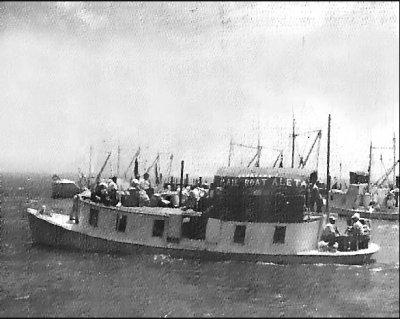Stories of Saltwater Heritage
An entire shelf in our living room book case is filled with books about the Outer Banks. From the historical accounts of David Stick and Rodney Barfield to the ghost legends of Charles Harry Whedbee and Philip Howard, folklore, nature guides, photography, covering the North Carolina coast from Little River Inlet to the Virginia Line, it’s pretty much all there.
But I want to tell you about the most recent book to join the collection. I just finished reading it and I enjoyed every page. It’s called Living at the Water’s Edge: A Heritage Guide to the Outer Banks Byway by a couple of “Core Sounders” named Barbara Garrity-Blake and Karen Willis Amspacher, published this year by the University of North Carolina Press in Chapel Hill.
The book covers the entire route of the Outer Banks Scenic Byway (N.C. Highways 12 and 70) from Whalebone Junction to Bettie (just downeast of Beaufort) from a variety of perspectives ranging from the geological/meteorological to the human/historical. It’s delightfully salted with photographs dating from the 1880s to the present and sidebars covering interesting Outer Banks people and other attractions.
Although I’m not a native of the Outer Banks my association with this fascinating part of the world spans 72 years. Ever noticed how memories are most powerfully triggered by the olfactory sense? Every time I smell a kerosene lantern burning I have vivid memories of childhood times spent at the little waterfront cabin my father built on Harker’s Island in the 1940s. I’ve returned to Harker’s Island a few times in recent years and it looks nothing like what I remember but this book’s discussion of the island’s people and history provides a glimpse back into that time. Willis and Rose are names I associate with some of the grownups I knew back then.
My brother and I once watched a young man named Kenny trying to dismantle an old house by knocking down interior walls with a sledge hammer. Suddenly we heard him emit a loud oath in a heavy brogue before sprinting out from under a rapidly-collapsing roof. It made such an impression on our young minds that for months thereafter, we played “The House That Fell Down on Kenny.” The house was usually represented by a book propped up on one end by a match -stick. A second matchstick represented Kenny who would dart out from under the book, yelling something like, “Croistamoity!” as the supporting matchstick was knocked out of place.

The combined smell of diesel fuel and fish brings me right back to my first trip to Ocracoke on the mail boat from Atlantic in 1952. And each time I take a ferry to or from my home on Ocracoke, the diesel smells, the prop vibrations, and the cries of the laughing gulls transport me back to the two ferry crossings (Alligator River and Croatan Sound) between my childhood home in Rocky Mount and my mother’s family’s unpainted oceanfront house at Nags Head, two doors north of the long-gone Arlington Hotel.
This new book is packed with people, places and things quite familiar to me from old-timers I knew (Roy Parsons, Muzel Bryant) to the “apple ugly” from Buxton’s Orange Blossom Bakery, which is one of my favorite sinful indulgences (I know – things change as you get older!) But it’s also full of stuff I never knew about like the popular belief among Cedar Islanders that theirs was the actual site of Sir Walter Raleigh’s lost colony rather than Roanoke Island.
Although I don’t know either of them well, I’ve been acquainted with the authors for many years so I wasn’t at all surprised that local boatbuilding was strongly featured in the book. Both women are married to highly skilled wooden boat builders. And along with hard work, danger, heartbreak, and joy, there is a thread of music woven through the book. Not surprising either since Garrity-Blake and her husband are talented musical performers.

As I read, parts of a favorite folk song kept coming to mind from a different section of our coast with a similar heritage:
I remember the time when you worked for a living
Pulling hard just to get back to shore
When you busted your back
Or you just wouldn't eat
They don't talk much of that anymore
When you sat with the old folks, fell asleep from their stories
Stayed awake with the howling winds;
Sang your songs till the children were all tucked away warm
And the night tides come rollin' back in.
Get me my fiddle, we’ll sing all the old songs
You take the high notes and I’ll sing the low
Good times and hard times they’re all worth the tellin’
Don’t matter to me if you sing ‘em that well.
Larry Kaplan, Song for Gale. 1988
Living at the Water’s Edge: A Heritage Guide to the Outer Banks Byway is available at Books to Be Red and other island bookshelves on Ocracoke.



